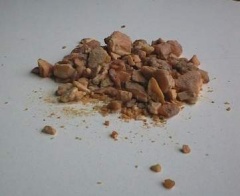Benzoin Resin
| Infobox on Benzoin Resin | |
|---|---|
| Example of Benzoin Resin |  |
| Facts | |
| Origin | - |
| Stowage factor (in m3/t) | 2,5 m3/t (bags) |
| Humidity / moisture | - |
| Ventilation | - |
| Risk factors | See text |
Benzoin Resin
Description
Benzoin resin or styrax resin is a balsamic resin obtained from the bark of several species of trees in the genus Styrax. Its principal component is benzoic acid. Commonly called "benzoin", it is called "benzoin resin" here to distinguish it from the crystalline compound benzoin. Benzoin resin does not contain this crystalline compound.
Benzoin is also called gum benzoin or gum benjamin, but "gum" is incorrect as benzoin is not a water-soluble polysaccharide.
Application
Benzoin resin is used in the manufacture of varnishes, perfumery and medicinal preparations.
Shipment/storage/risk factor
Benzoin resin is a hard gum-resin shipped in cases and sacks. It has the appearance of ‘crumbled stones’ in pieces of various sizes, the largest having the greater value.
Bags of benzoin submitted to heat and pressure also stick together, quickly causing depreciation. High value pieces are often shipped in cases to give better protection against pressure.
Quality is not impaired by wetting or dampness. Dust or other foreign matter will stick to benzoin causing depreciation, as cleansing is difficult and costly. Loss of weight should not occur when the commodity is packed in zinc cases, but when packed in ordinary wooden cases or wooden barrels loss may occur unless the cracks in the wood are filled with mastic. Is sensitive to odours.
When fresh Benzoin resin is of a light brown colour, becoming brown-red when old. The value increases with age. Breakage can arise because of the brittle nature of the gum, especially among the larger and more valuable pieces. This leads to loss in value. The heat of the sun is sufficient to cause softening, causing the pieces to stick together. The commodity then has the same value as benzoin dust.











